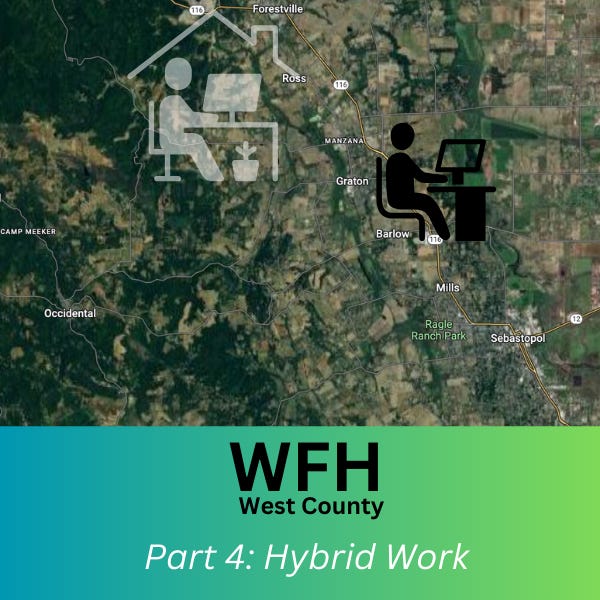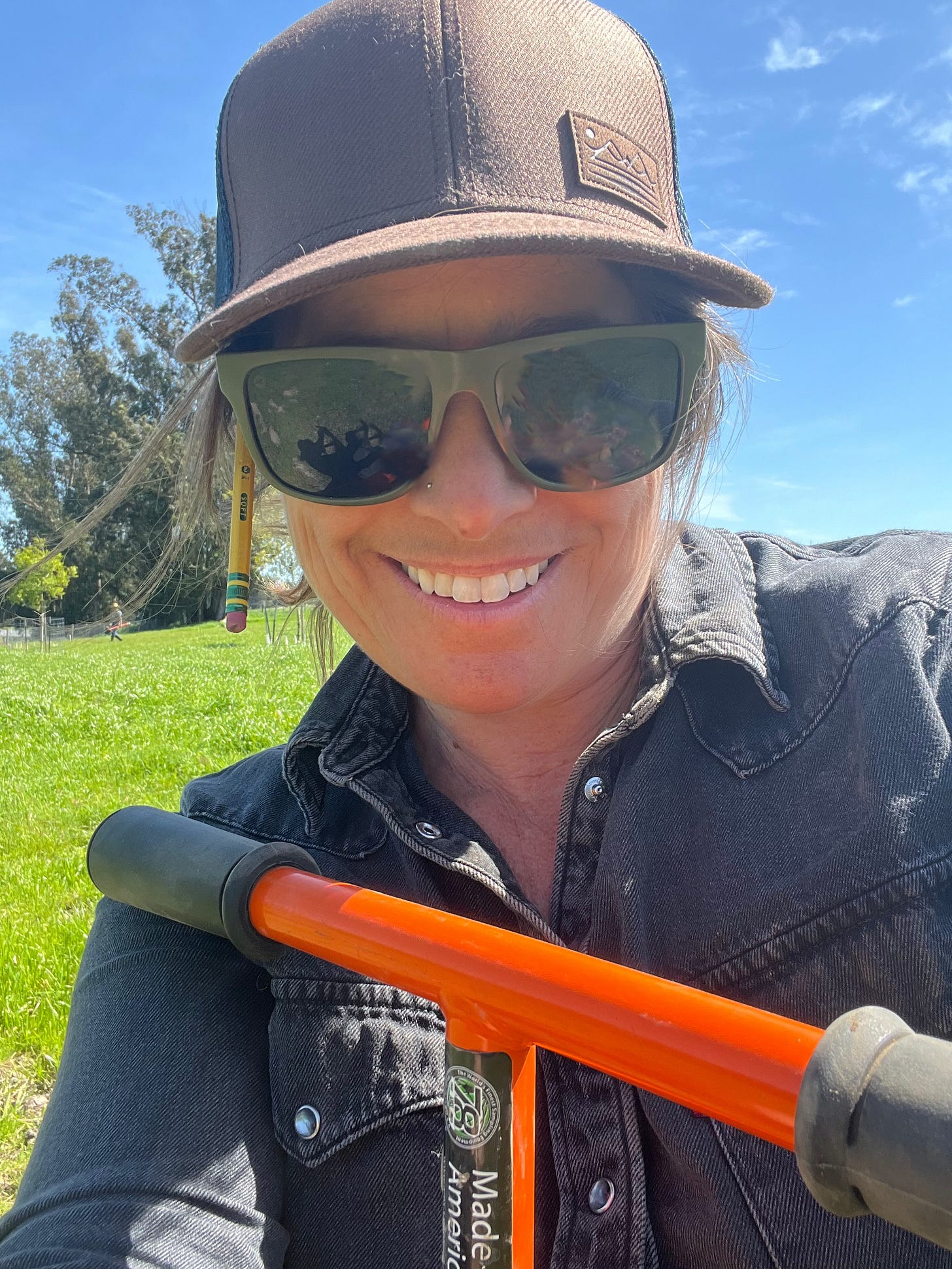WFH West County: Hybrid Work
Part 4 - Hybrid workers split their time in and out of the office; meet Kat Deaner, a conservation planner, who works from home some days and also goes outside in the fields
This is the fourth of a five-part series that looks at the shift to remote work in Sebastopol and West County, what might be considered a hidden-away-at-home workforce. WFH is changing where and how people work today, offering a good living in a good place to live and work. Catch up:
While some work from home 100% of the time, others are hybrid workers, where they work in an office one or more days a week.
The Pew Research Center study on 2023 says that nearly half of those working remotely have a hybrid schedule.
41% of those with jobs that can be done remotely are working a hybrid schedule – that is, working from home some days and from the office, workplace or job site other days. This is up from 35% in January 2022.
Among hybrid workers who are not self-employed, most (63%) say their employer requires them to work in person a certain number of days per week or month. About six-in-ten hybrid workers (59%) say they work from home three or more days in a typical week, while 41% say they do so two days or fewer.
Kat Deaner has worked in an office with colleagues, worked remotely from home 100% in two jobs which felt very different, along the way moving from Ohio to New Mexico and then northern California. Now, Kat has a hybrid job working a few days at home and a few days in the office or out in the field. And she really likes both parts of her job.
WFH Profile - “The other days I'm out in the field, literally in the field.”
Kat Deaner, Conservation Planner and STEM Educator
Kat Deaner is a conservation planner but she started working from home when her husband’s job change took her from Ohio to New Mexico and then to Forestville. Now she’s a “hybrid” worker because she works several days at home and she also works out in the field, “literally in the field,” she says. She likes that her job is very flexible.
“ What I do now is very different than what I did a decade ago. And I'm thrilled about that. As my career has evolved, it's been wonderful to pivot. Right now, I'm a conservation planner. I work for Gold Ridge Resource Conservation District (RCD) here in Graton. I am on the ag team.”
“I work directly with producers in our district to plan and implement conservation practices on their land or the land that they are producing – not all of them are landowners. Some of them are leases. I've been in this job about four months now. I’m pretty new.”
“It's really a hybrid position where I work some days from my home office. Other days I work in the office at Gold Ridge RCD on the Dutton Ranch. Then the other days I'm out in the field, literally in the field.”
It's a really nice balance between being at home in my home office, being out, literally out in the field and in the landscape, and then being in the office where I can interact with my colleagues. It's a really great balance.
Kat works with 14 people at Gold Ridge RCD. Some choose to be in the office five days a week while others choose to have kind of schedule that Kat does. “It's flexible, and the organization itself is pretty agile.”
Kat got her undergraduate degree in Environmental Science from UC Santa Cruz and then went to Ohio State University to get two master’s degrees, one in Horticulture and Crop Science and the other in agricultural education. During much of that time, she ran a farm school, an outdoor STEM learning lab in urban agriculture for high school.
She took a job at an educational nonprofit, PAST Foundation, in Columbus, Ohio, developing STEM curriculum. She worked in the office and worked on programs in a 35,000 square foot innovation lab for students. Then her husband, Josh, who is a soil scientist, took a job at New Mexico State University in Las Cruces, NM.
“I went remote. It was novel at the time just to go remote, and I was the only employee that went remote. I was also in a leadership role, so I managed people remotely,” she said. The nonprofit had had clients throughout Ohio, as well as upstate New York, Alaska and South Dakota. She would have to travel to meet with these clients from Ohio, but now her trips started in New Mexico.
She was part of a team building up an online learning division so that teachers could take online learning classes in STEM and problem-based learning.
Then her husband took a job at Santa Rosa Junior College running the Sustainable Ag program as a faculty member. “So we ended up in Sonoma County. I was still working for PAST Foundation at the time, and still doing professional development work and leadership work with school districts and administrators.” She was able to continue working at the PAST Foundation, which fostered a culture of innovation “that made it easier for them to shift to remote work.” The organization was itself working remotely with teachers. “Remember this was ten years ago, pre-COVID, so there was a lot of skill building, getting on Zoom with teachers who had never gotten on Zoom or had never done a video call.”
She eventually decided to leave the PAST Foundation. The organization wanted her to consider becoming its leader, which would require moving back to Ohio. She didn’t want to move. She found an opportunity to go out on her own as a consultant.
“I was just ready for a change,” she said. “I thought this was a good time for me to go out on my own. Also, my twins were born, so I had two young children, and I wanted even more flexibility while they were toddlers.” Working at home while raising children is very hard.
Her new job was working for a government contractor managing grants at minority-serving institutions. She was remote from day one, and it was a much different experience for her. “I never actually met my supervisors in person. I met one of my team members in person, so I led a team of five and then I reported to a couple people.”
In her previous job, she had been physically in the office, and she knew everyone she worked with. “I knew all of them. I knew their families. We would go out to eat,” she said. None of that happened in her new job. “It was very impersonal,” she said.
“Contractors are the workhorses of the federal government, and I got a little burnt out being a workhorse and from the impersonal nature of the job. I like to connect with humans,” she said.
At home, Kat works from “an old converted walk-in closet.” It required some renovation. “This closet was originally intended to be a bathroom when they added it onto the house. What we did is take all the shelving out and I popped a window out and it’s my office.”
She says that there are some tricks and trade-offs to working remotely. “The work-life balance gets really blurry,” she said. “If you're working from home, it's really easy to check your email, go into your office at eight o'clock at night and never be off. I have three young children and a family and other passions outside my work. I have to be really disciplined around scheduling. Discipline is really important. I used to do some rituals. I would have a bell that I would have to ring to consciously say, ‘I'm now moving into a different mindset,’ right?”
“When I started working remotely here in Sonoma County, I had a colleague who lived in Napa and so she and I would occasionally get together and work at the active CoLab in Santa Rosa in downtown. That was a nice way to get out of my house because it's important to get out of my house. Sometimes even if she didn't go, I would go there, just to be with other professionals and be in an office setting where I put on something other than yoga pants.”
Next Monday, our five-part series will conclude with another West County couple who both work from home.




